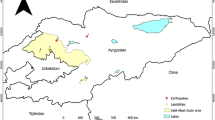Abstract
Slope instability hazard assessment is based on theanalysis of the terrain conditions at sites whereslope failures occurred in the past. For the analysisof the causative factors the application of geographicinformation systems (GIS) is an essential tool in thedata analysis and the subsequent hazard assessment.Three scale levels of hazard mapping are defined – adirect experience-driven mapping at reconnaissancelevel, a statistical approach to determine thecausative factors in a quantitative susceptibilitymapping, and a methodology at large scale making use ofdeterministic models.
Similar content being viewed by others
References
Anderson, M.G. and Kemp, M.J.: 1991, ‘Towards an improved specification of slope hydrology in the analysis of slope instability problems in the tropics’, Progress in Physical Geography 15(1), 29–52.
Asch, Th.W.J. van, Westen, C.J. van, Blijenberg, H. and Terlien, M.T.J.: 1992, ‘Quantitative landslide hazard analysis in volcanic ashes of the Chinchina area, Colombia’, Proceedings Primer Simposio Internacional sobre sensores remotos y sistemas de informacion geografica pare el estudio de riesgos naturales, Bogota, Colombia, pp. 433–443.
Asch, Th.W.. van, Kuipers, B. and Zanden, D.J. van der: 1993, ‘An information system for large scale quantitative hazard analysis on landslides’, Zeitschrift fur Geomorphologie N.F., Suppl.-Bd 87, 133–140.
Bonham-Carter, G.F.: 1994, ‘Geographic information systems for geoscientists; modelling with GIS’, Computer Methods in Geosciences, Vol. 13, Pergamon Press, 398 pp.
Benda, L. and Zhang, W.: 1990, ‘Accounting for the stochastic occurrences of landslides when predicting sediment yields’, Proceedings of the Fiji Symposium, IAHS-AISH Publ. 192, pp. 115–127.
Brass, A., Wadge, G. and Reading, A.J.: 1989, ‘Designing a geographical information system for the prediction of landsliding potential in the West Indies’, Proceedings Economic Geology and Geotechnics of Active Tectonic Regions, London, England.
Burrough, P.A.: 1986, ‘Principles of geographic information systems for land resource management’, Monographs on Soils and Resources Surveys, No. 12, Clarendon Press, Oxford, 193 pp.
Carrara, A.: 1988, ‘Multivariate models for landslide hazard evaluation. A “black box” approach’, Workshop on Natural Disasters in European Mediterranean Countries, Perugia, Italy, pp. 205–224.
Carrara, A., Cardinali, M. and Guzzetti, F.: 1992, ‘Uncertainty in assessing landslide hazard risk’, ITC Journal 1992-2, 172–183.
Chung, C.F. and Fabbri, A.G.: 1993, ‘The representation of geoscience information for data integration’, Nonrenewable Resources 2(2), 122–139.
Coppock, J.T.: 1995, ‘GIS and natural hazard: an overview from a GIS perspective’, in A. Carrara and F. Guzzetti (eds), Geographic Information Systems in Assessing Natural Hazards, Kluwer Academic Publishers, pp. 21–34.
Fournier d'Albe, E.M.: 1976, ‘Natural disasters’, Bull. Int. Assoc. of Eng. Geol. 14, 187.
Graham, J.: 1984, ‘Methods of slope stability analysis’, in D. Brunsden and D.B. Prior (eds), Slope Instability, John Wiley & Sons, pp. 171–215.
Hammond, C.J., Prellwitz, R.W. and Miller, S.M.: 1992, ‘Landslide hazard assessment using Monte Carlo simulation’, in D.H. Bell (ed.), Proceedings of the sixth International Symposium on Landslides, Christchurch, New Zealand, Balkema, pp. 959–964.
Naranjo, J.L., vanWesten, C.J. and Soeters, R.: 1994, ‘Evaluating the use of training areas in bivariate statistical landslide hazard analysis - a case study in Colombia’, ITC Journal 1994-3, 292–300.
Nash, D.: 1987, ‘A comparative review of limit equilibrium methods of slope stability analysis’, in M.G. Anderson and K.J. Richards (eds), Slope Stability, John Wiley & Sons, pp. 11–75.
Okimura, T. and Kawatani, T.: 1987, ‘Mapping of the potential surface failure sites on granite mountain slopes’, in V. Gardiner (ed.), International Geomorphology, Part 1, John Wiley & Sons, pp. 121–138.
Rulon, J.J. and Freeze, R.A.: 1985, ‘Multiple seepage faces on layered slopes and their implication for slope stability analysis’, Canadian Geotechnical Journal 22, 347–356.
Soeters, R. and Westen, C.J. van: 1996, ‘Slope instability recognition, analysis and zonation’, in A.K. Turner and R.L. Schuster (eds), Landslides Investigation and Mitigation, Transportation Research Board, Special Report 247, National Academy Press, Washington, pp. 129–177.
Swiss Reinsurance Company: 1990, Economic losses and insured losses due to natural disasters 1960-1989, Sigma 2/90.
Terlien, M.T.J., Asch, Th.W.J. van, and Westen, C.J. van: 1995, ‘Deterministic modelling in GIS-based landslide hazard assessment’, in A. Carrara and F. Guzzetti (eds), Geographical Information Systems in Assessing Natural Hazards, Kluwer Academic Publishers, pp. 57–77.
Terlien, M.T.J.: 1996, Modelling spatial and temporal variations in rainfall-triggered landslides. Ph.D. thesis, ITC Publ. Nr. 32, Enschede, The Netherlands, 254 pp.
Varnes, D.J.: 1984, Landslide Hazard Zonation: a review of principles and practice. Commission on landslides of the IAEG, UNESCO, Natural Hazards, No. 3, 61 pp.
Wadge, G.: 1988, ‘The potential of GIS modelling of gravity flows and slope instabilities’, Int. J. Geographic Information Systems 2(2), 143–152.
Ward, T.J., Li, R.M. and Simons, D.B.: 1981, ‘Use of a mathematical model for estimating potential landslide sites in steep forested drainage basins’, in Erosion and Sedimentation in the Pacific Rim Steeplands, IAHS publ. 132, pp. 21–41.
Ward, T.J., Li, R.M. and Simons, D.B.: 1982, ‘Mapping landslides in forested watersheds’, Journal of the Geotechnical Engineering Division 8, 319–324.
Van Westen, C.J., Van Duren, I, Kruse, H.M.G. and Terlien, M.T.J.: 1993, GISSIZ: training package for Geographic Information Systems in Slope Instability Zonation. ITC-Publication Number 15, ITC, Enschede, The Netherlands, Volume 1: Theory, 245 pp. Volume 2: Exercises, 359 pp. 10 diskettes.
Yin, K.J. and Yan, T.Z.: 1988, Statistical prediction model for slope instability of metamorphosed rock, Proceedings 5th International Symposium on Landslides, Lausanne, Switserland, Vol. 2, 1269–1272.
Author information
Authors and Affiliations
Rights and permissions
About this article
Cite this article
Van Westen, C.J. The Modelling Of Landslide Hazards Using Gis. Surveys in Geophysics 21, 241–255 (2000). https://doi.org/10.1023/A:1006794127521
Issue Date:
DOI: https://doi.org/10.1023/A:1006794127521




